Design of Monolithic 2D Optical Phased Arrays Heterogeneously Integrated with On-Chip Laser Arrays Based on SOI Photonic Platform
Abstract
:1. Introduction
2. Design and Simulation
2.1. Overall Description of the 2D OPAs Integrated with On-Chip Laser Arrays
2.2. Design for On-Chip Heterogeneous-Integration MQW Laser Arrays (Section A)
2.3. Design for the EO Switch Array and Phase-Shifter Array (Section B)
2.4. Design for Grating Emitter Arrays (Section C)
3. Conclusions
Author Contributions
Funding
Institutional Review Board Statement
Informed Consent Statement
Data Availability Statement
Conflicts of Interest
References
- Heck, M.J.R.; Bauters, J.F.; Davenport, M.L.; Doylend, J.K.; Jain, S.; Kurczveil, G.; Srinivasan, S.; Tang, Y.; Bowers, J.E. Hybrid Silicon Photonic Integrated Circuit Technology. IEEE J. Sel. Top. Quant. 2013, 19, 6100117. [Google Scholar] [CrossRef] [Green Version]
- Paramjeet, K.; Andreas, B.; Guanghui, R.; Thach, G.N.; Gunther, R.; Arnan, M. Hybrid and heterogeneous photonic integration. APL Photon. 2021, 6, 061102. [Google Scholar]
- Luo, G.; Pan, J.; Wang, P.; Ma, J.; Wang, R.; Yang, Z.; Xu, Y.; Yu, H.; Zhou, X.; Zhang, Y.; et al. Demonstration of 128-Channel Optical Phased Array with Large Scanning Range. IEEE Photonics J. 2021, 13, 6800710. [Google Scholar] [CrossRef]
- Daivid, F.; Sylvain, G.; Jonathan, F.T.; Nicola, A.T.; Bertrand, S. Integrated Optical Phased Array Based on a Binary Splitter Tree with Reduced Number of Control Voltages. J. Light. Technol. 2022, 40, 4027–4032. [Google Scholar]
- Christopher, V.P.; Ami, Y.; David, B.C.; Matthew, J.B.; Manan, R. Coherent solid-state LIDAR with silicon photonic optical phased arrays. Opt. Lett. 2017, 42, 4091–4094. [Google Scholar]
- Tao, D.; Jingwen, H.; Xinyu, H.; Yue, X.; Jianming, Z. Hybrid design approach of optical phased array with wide beam steering range and low side-lobe level. Opt. Lett. 2022, 47, 806–809. [Google Scholar]
- Farshid, A.; Firooz, A. N × N optical phased array with 2N phase shifters. Opt. Express 2019, 27, 27183–27190. [Google Scholar]
- Pascual, M.; Daniel, P.; Luis, A.B.; Gloria, M.C.; Jesus, B. Scalable Switched Slab Coupler Based Optical Phased Array on Silicon Nitride. IEEE J. Sel. Top. Quant. 2022, 28, 8300416. [Google Scholar]
- David, K.; Amir, H.; John, C.; Yang, Z.; Xiaochuan, X. On-chip silicon optical phased array for two-dimensional beam steering. IEEE J. Sel. Top. Quant. 2022, 28, 8300416. [Google Scholar]
- Min, C.S.; Aseema, M.; Gang, Z.; Kyle, W.; Gaurang, R.B.; Christopher, T.P.; Steven, A.M. Chip-scale blue light phased array. Opt. Lett. 2020, 45, 1934–1937. [Google Scholar]
- Ren, Y.; Zhang, L.; Zhao, W.; Wang, G.; Feng, N.; Wu, W.; Sun, X.; Zhang, W. Compact 2D serpentine optical phased array. Appl. Opt. 2021, 60, 7158–7163. [Google Scholar] [CrossRef] [PubMed]
- Binghui, L.; Caiming, S.; Hongjie, W.; Zhenmin, C.; Xiaomin, N. Liquid-cladded optical phased array for a single-wavelength beam steering. Opt. Lett. 2021, 46, 4948–4951. [Google Scholar]
- Sung-Moon, K.; Eun-Su, L.; Kwon-Wook, C.; Jinung, J.; Min-Cheol, O. Compact solid-state optical phased array beam scanners based on polymeric photonic integrated circuits. Sci. Rep. 2021, 11, 10576. [Google Scholar]
- Weiqiang, X.; Chao, X.; Lin, C.; Warren, J.; Jonathan, P.; Johne, E.B. Silicon-integrated nonlinear III-V photonics. Photonics Res. 2022, 10, 535–541. [Google Scholar]
- Alan, Y.L.; John, B. Photonic Integration with Epitaxial III–V on Silicon. IEEE J. Sel. Top. Quant. 2018, 24, 6000412. [Google Scholar]
- Mingjun, X.; Ying, D.; Tianyu, S.; Miao, M. Design and analysis of an InGaAs/InGaAsP quantum well microlaser with longitudinal periodical strain distribution for single-mode lasing. Appl. Opt. 2022, 61, 84–90. [Google Scholar]
- William, S.F.; Se-Heon, K.; Pablo, A.P.; Axel, S. Hybrid single quantum well InP/Si nanobeam lasers for silicon photonics. Opt. Lett. 2013, 38, 4656–4658. [Google Scholar]
- Yu, H.; Wai, K.N.; Ying, X.; Qiang, L.; Kam, S.W.; Kei, M.L. Telecom InP/InGaAs nanolaser array directly grown on (001) silicon-on-insulator. Opt. Lett. 2019, 44, 767–770. [Google Scholar]
- Jun, G.; Hiroyuki, I.; Takemasa, T.; Toshihiko, B. Space-time-domain observation of high-speed optical beam scanning in a thermo-optic Si photonic crystal slow-light beam scanner. Opt. Lett. 2021, 46, 3600–3603. [Google Scholar]
- Toshihiko, B.; Takemasa, T.; Hiroyuki, I.; Mikiya, K.; Ryo, T. Silicon Photonics FMCW LiDAR Chip with a Slow-Light Grating Beam Scanner. IEEE J. Sel. Top. Quant. 2022, 28, 8300208. [Google Scholar]
- Zhang, Z.; Yu, H.; Huang, Q.; Zhou, Z.; Chen, B.; Dai, T.; Qiu, H.; Wang, Y.; Yang, J. High-Speed and Low-Power Silicon Optical Phased Array Based on the Carrier-Depletion Mechanism. IEEE Photon. Technol. Lett. 2022, 34, 271–274. [Google Scholar] [CrossRef]
- Hiraki, T.; Aihara, T.; Fujii, T.; Takeda, K.; Matsuo, S. Membrane InGaAsP Mach–Zehnder Modulator Integrated with Optical Amplifier on Si Platform. J. Light. Technol. 2020, 38, 3030–3036. [Google Scholar] [CrossRef]
- Óscar, G.L.; Dries, V.T.; Steven, V.; Manuel, L.A.; Roel, B.; Marko, G. Vertically Coupled InP/InGaAsP Microring Lasers Using a Single Epitaxial Growth and Single-Side Lithography. J. Light. Technol. 2020, 38, 3983–3987. [Google Scholar]
- Claire, B.; Delphine, N.; Dalila, M.; Joan, M.R.; Giancarlo, C. AlGaInAs Multi-Quantum Well Lasers on Silicon-on-Insulator Photonic Integrated Circuits Based on InP-Seed-Bonding and Epitaxial Regrowth. Appl. Sci. 2022, 12, 263. [Google Scholar]
- Yangjeng, C.; Yihsin, F.; Rihyou, C.; Conglong, C.; Bohong, C.; Yijen, C. Vertical Hybrid Integration Devices Using Selectively Defining Underneath Si Waveguide. IEEE Photon. Technol. Lett. 2021, 33, 1325–1328. [Google Scholar]
- Chen, C.; Li, J.; Wang, C.; Huang, Y.; Zhang, D.; Shi, Z.; Cui, Z.; Yi, F.; Ho, S.-T. Study of an Integration Platform Based on an Adiabatic Active-Layer Waveguide Connection for InP Photonic Device Integration Mirroring That of Heterogeneous Integration on Silicon. Photonics 2021, 8, 433. [Google Scholar] [CrossRef]
- Xiangyu, G.; Zhen, L.; Haihong, C.; Yunlong, L.; Mengyuan, Y. Two-dimensional silicon optical phased array with large field of view. Opt. Express 2022, 30, 28049–28056. [Google Scholar]
- Wang, Y.; Zhou, G.; Zhang, X.; Kwon, K.; Blanche, P.-A.; Triesault, N.; Yu, K.-S.; Wu, M.C. 2D broadband beamsteering with large-scale MEMS optical phased array. Optical 2019, 6, 557–562. [Google Scholar] [CrossRef]


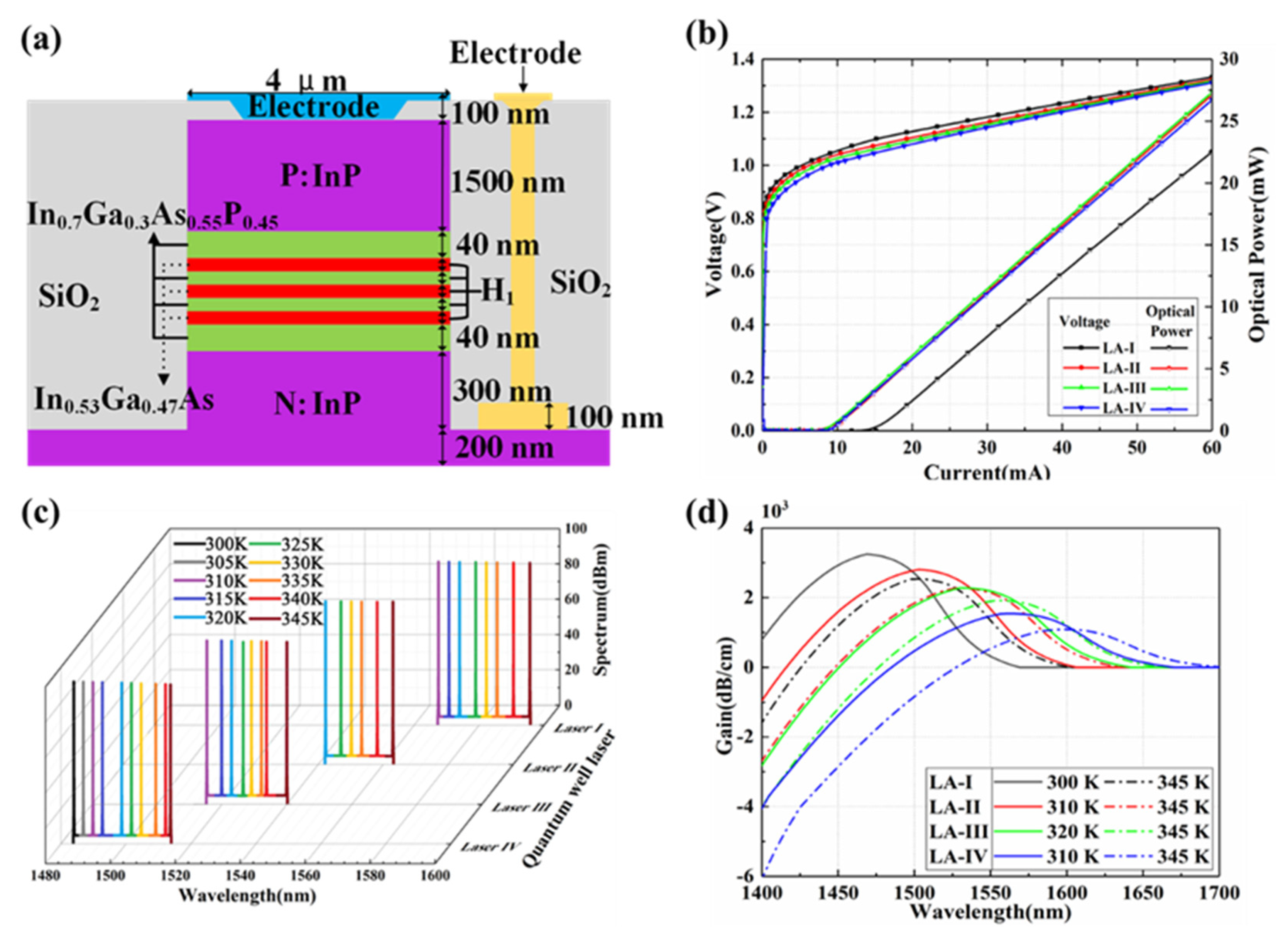
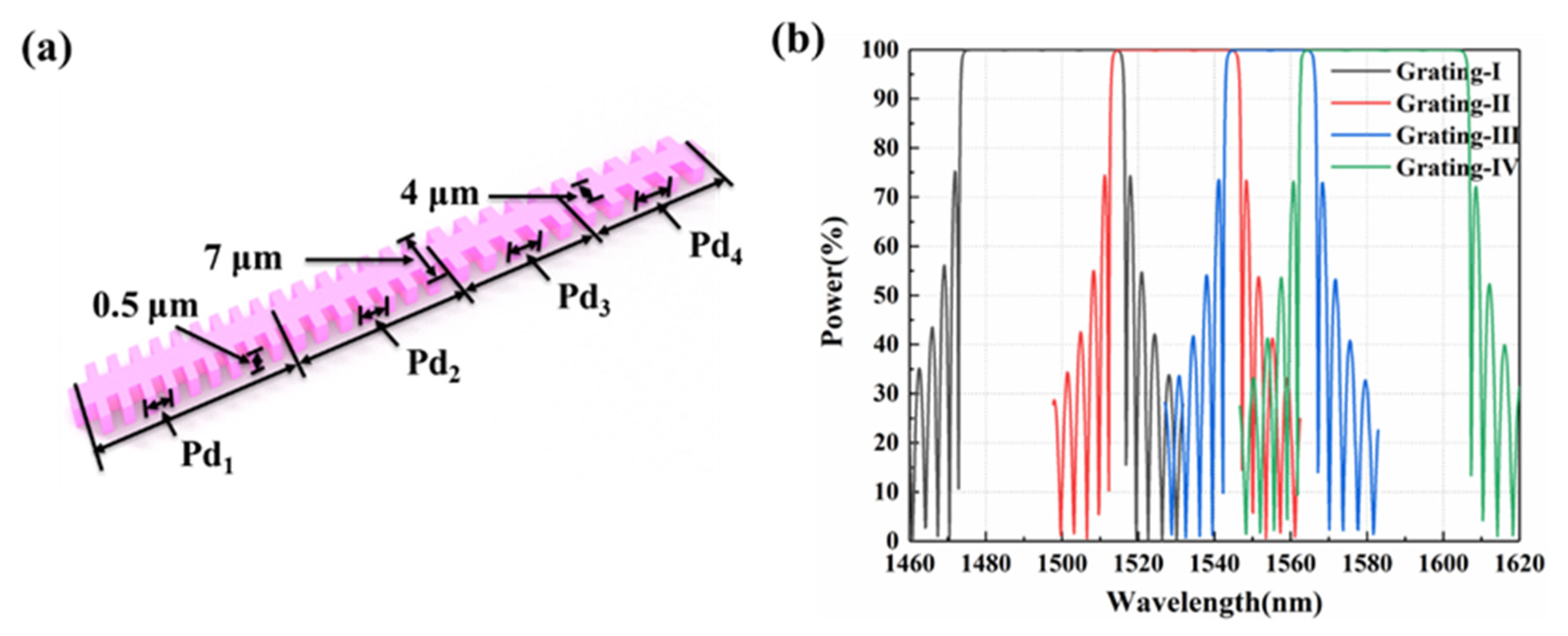
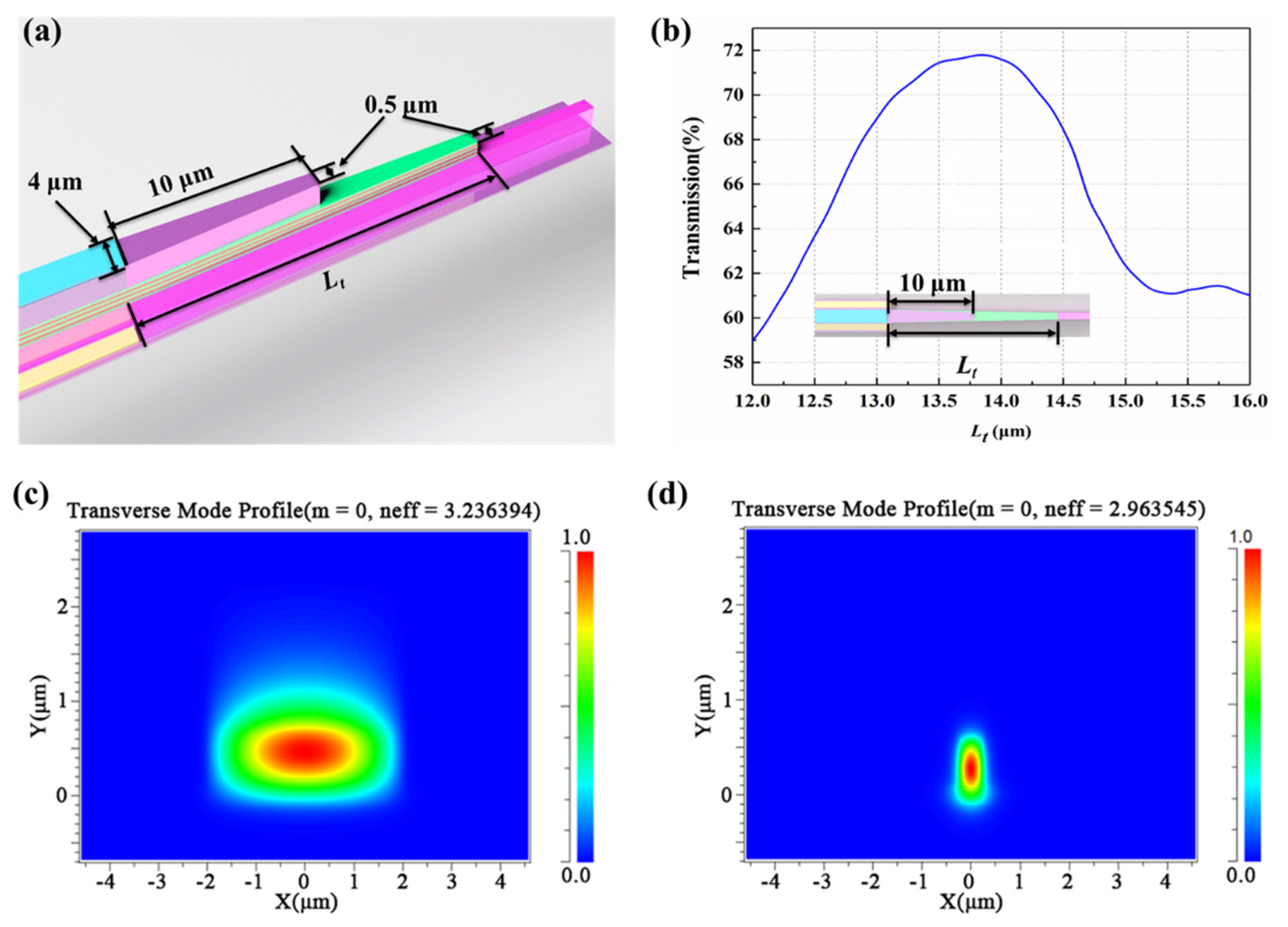
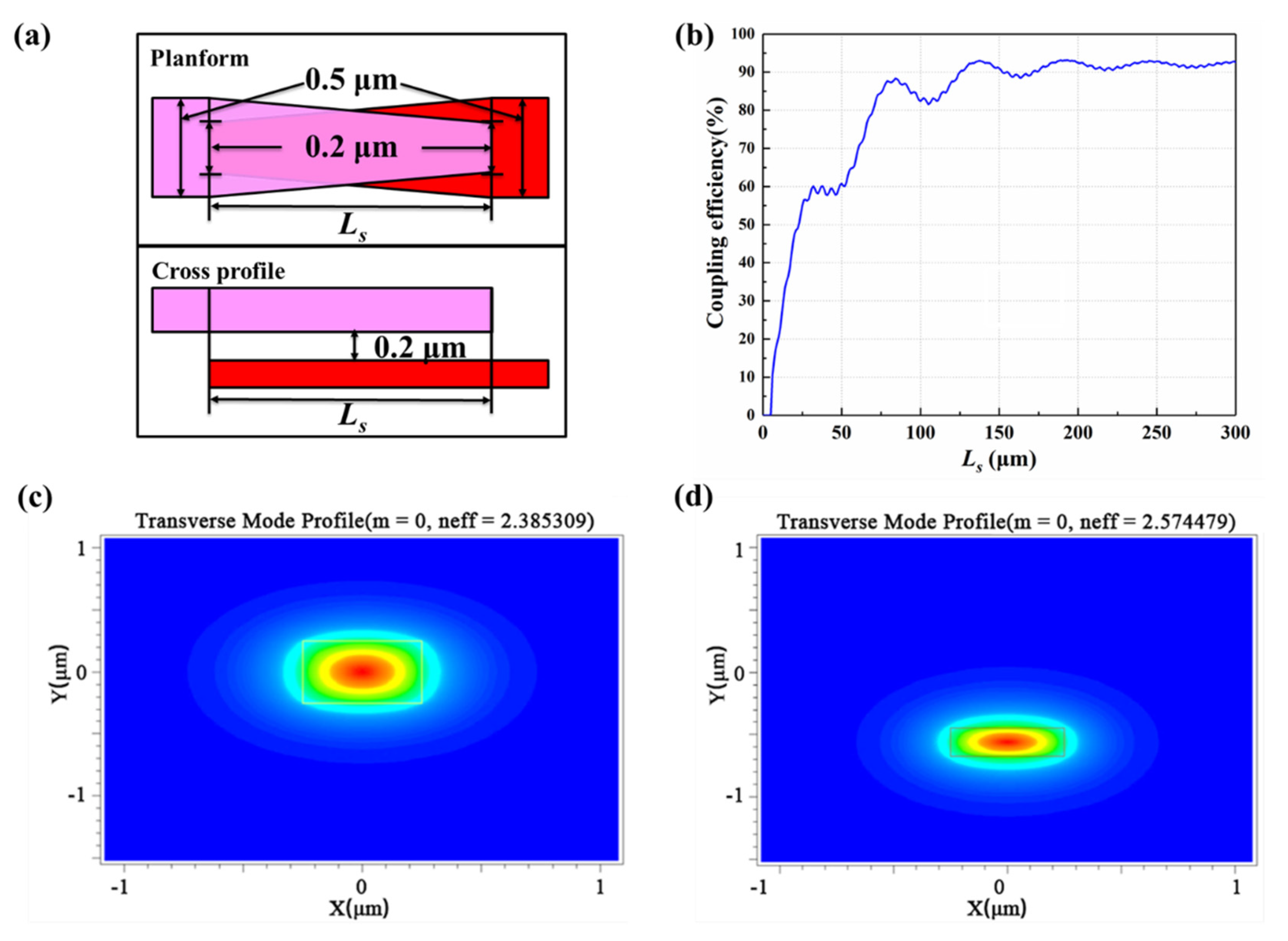
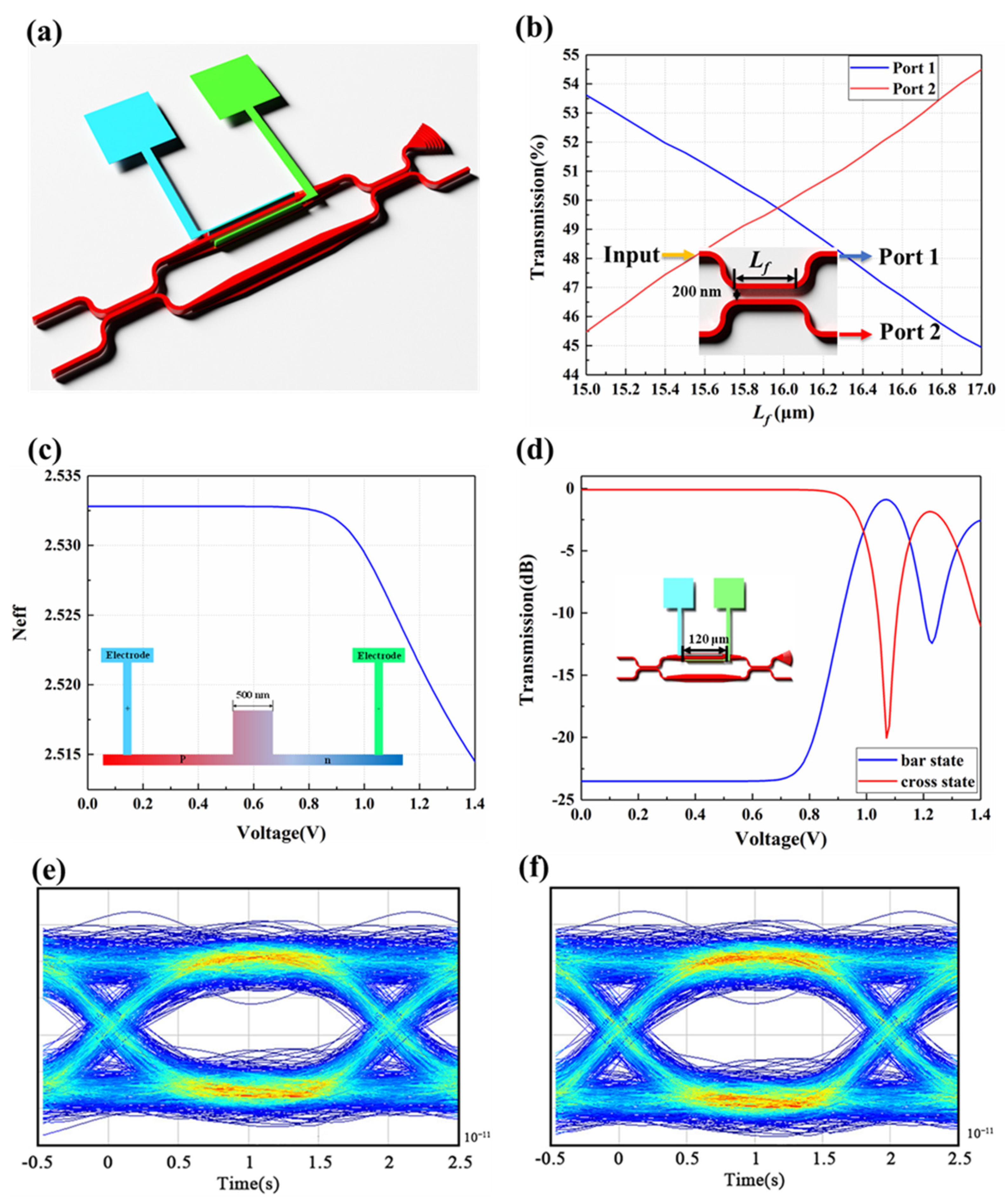
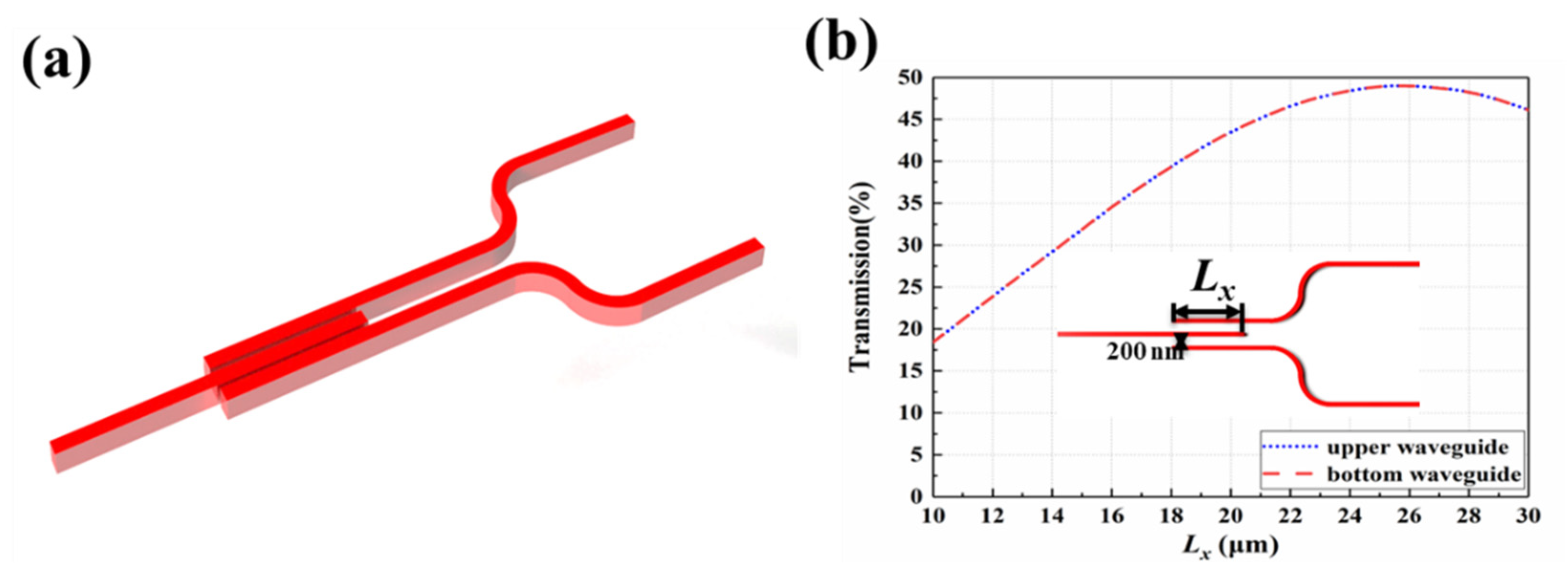



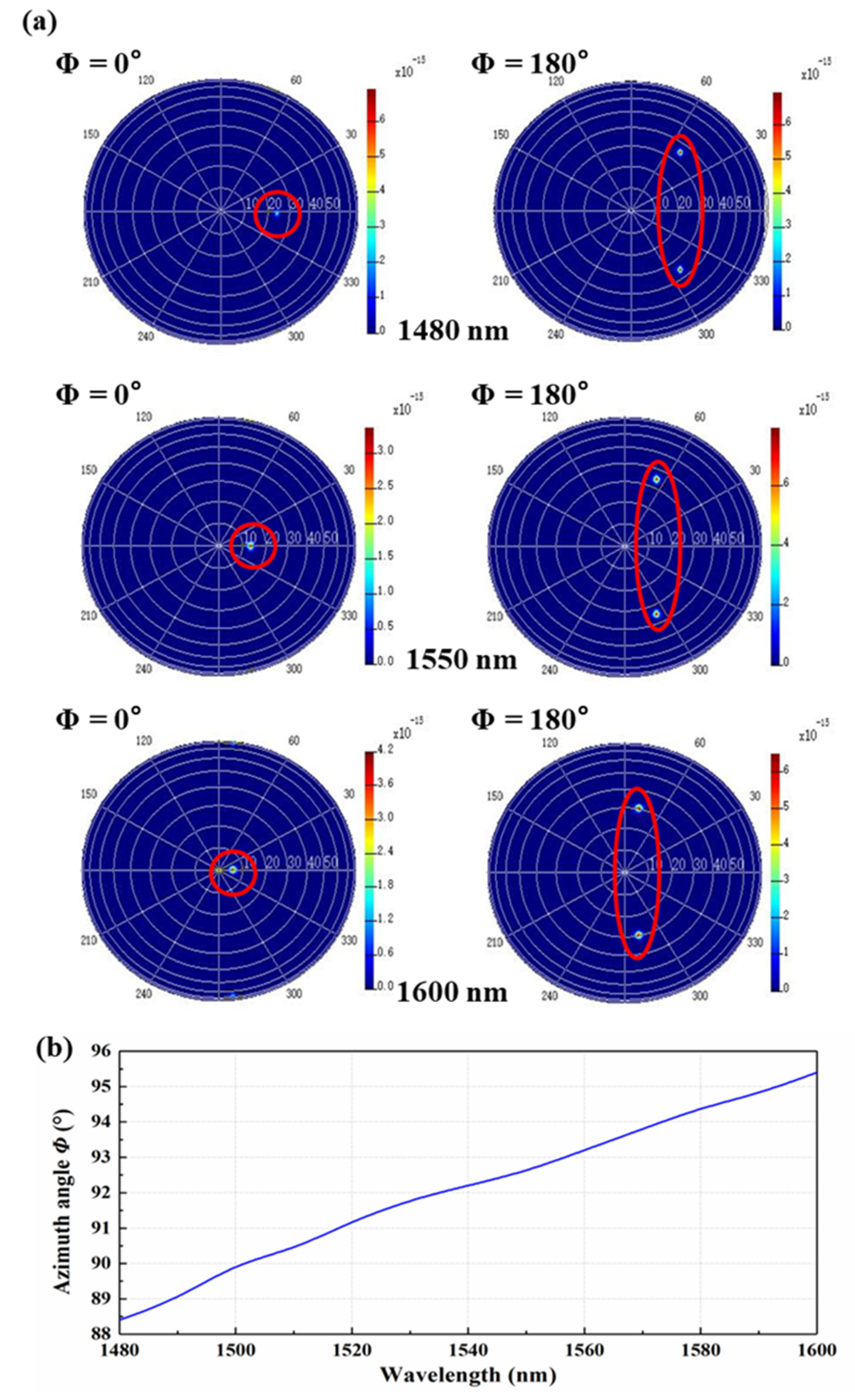
| Layer Definition | Type | Thickness | Material | Refractive Index | Carrier Concentration |
|---|---|---|---|---|---|
| P-cladding | P | 1500 nm | InP | 3.17 | 1 × 1018 cm−3 |
| SCH barrier layer | I | 40 nm | In0.3Ga0.7As0.55P0.45 | 3.31 | |
| Well layer | I | H1 | In0.53Ga0.47As | 3.46 | |
| Barrier layer | I | H1 | In0.3Ga0.7As0.55P0.45 | 3.31 | |
| Well layer | I | H1 | In0.53Ga0.47As | 3.46 | |
| Barrier layer | I | H1 | In0.3Ga0.7As0.55P0.45 | 3.31 | |
| Well layer | I | H1 | In0.53Ga0.47As | 3.46 | |
| SCH barrier layer | I | 40 nm | In0.3Ga0.7As0.55P0.45 | 3.31 | |
| P-cladding | P | 200 nm | InP | 3.17 | 1 × 1018 cm−3 |
| Project | Grating-I | Grating-II | Grating-III | Grating-IV |
|---|---|---|---|---|
| Period 1(Pd1) (nm) | 1746.1 | 1802.2 | 1843.9 | 1871.9 |
| Period 1(Pd2) (nm) | 1760.3 | 1816.1 | 1857.9 | 1886.0 |
| Period 1(Pd3) (nm) | 1774.5 | 1830.0 | -- | 1900.0 |
| Period 1(Pd4) (nm) | 1788.4 | -- | -- | 1914.2 |
| The range of wavelength (nm) | 1474.2–1515.5 | 1513.6–1545.7 | 1543.7–1565.6 | 1563.2–1605.6 |
| Reflecting power | >99% | >99% | >99% | >99% |
| Working for laser array | LA-I | LA-II | LA-III | LA-IV |
| Source | Dimension | Size | Scanning Range | Type of the Phase Shifter | Modulation Rate | References |
|---|---|---|---|---|---|---|
| External lasers | 2D | 6 mm × 8 mm | 104.0° × 17.6° | TO | 0.67 μs | [3] |
| External lasers | 2D | N/A | 8.9° × 3.9° | TO | 7 and 21 ms | [13] |
| External lasers | 2D | 3.1 mm × 1.5 mm | 99.24° × 15.62° | TO | N/A | [27] |
| External lasers | 2D | 3.1 mm × 3.2 mm | 6.6° × 4.4° | TO | 5.7 μs | [28] |
| On-chip lasers | 2D | 8 mm × 3 mm | 88.4° × 18° | EO | 2.5 ps | Current study |
Publisher’s Note: MDPI stays neutral with regard to jurisdictional claims in published maps and institutional affiliations. |
© 2022 by the authors. Licensee MDPI, Basel, Switzerland. This article is an open access article distributed under the terms and conditions of the Creative Commons Attribution (CC BY) license (https://creativecommons.org/licenses/by/4.0/).
Share and Cite
Yue, J.; Cui, A.; Wang, F.; Han, L.; Dai, J.; Sun, X.; Lin, H.; Wang, C.; Chen, C.; Zhang, D. Design of Monolithic 2D Optical Phased Arrays Heterogeneously Integrated with On-Chip Laser Arrays Based on SOI Photonic Platform. Micromachines 2022, 13, 2117. https://doi.org/10.3390/mi13122117
Yue J, Cui A, Wang F, Han L, Dai J, Sun X, Lin H, Wang C, Chen C, Zhang D. Design of Monolithic 2D Optical Phased Arrays Heterogeneously Integrated with On-Chip Laser Arrays Based on SOI Photonic Platform. Micromachines. 2022; 13(12):2117. https://doi.org/10.3390/mi13122117
Chicago/Turabian StyleYue, Jian, Anqi Cui, Fei Wang, Lei Han, Jinguo Dai, Xiangyi Sun, Hang Lin, Chunxue Wang, Changming Chen, and Daming Zhang. 2022. "Design of Monolithic 2D Optical Phased Arrays Heterogeneously Integrated with On-Chip Laser Arrays Based on SOI Photonic Platform" Micromachines 13, no. 12: 2117. https://doi.org/10.3390/mi13122117
APA StyleYue, J., Cui, A., Wang, F., Han, L., Dai, J., Sun, X., Lin, H., Wang, C., Chen, C., & Zhang, D. (2022). Design of Monolithic 2D Optical Phased Arrays Heterogeneously Integrated with On-Chip Laser Arrays Based on SOI Photonic Platform. Micromachines, 13(12), 2117. https://doi.org/10.3390/mi13122117





